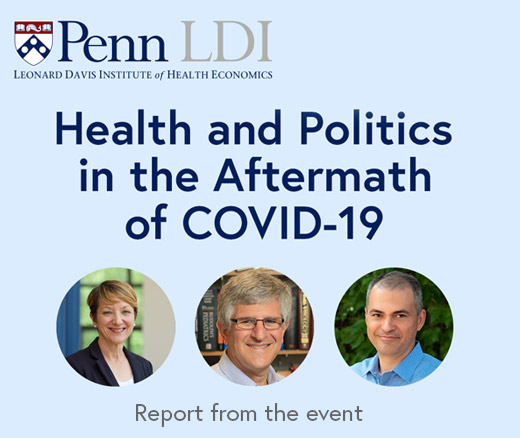
Contradictions That Confuse Federal Food Policies
Announcing Bold New Goals While Crippling the Infrastructure Needed to Achieve Them
Population Health
Brief

Helping people accurately understand their risk of dying or surviving may support public health campaigns years later. A new strategy for improving health behavior is supported by a randomized controlled trial from the long-running Malawi Longitudinal Study of Families and Health (MLSFH) that showed that a 2017 intervention to correct misconceptions about mortality risk was linked to higher COVID-19 vaccination rates five years later. Vaccination was 7.8 percentage points higher in the intervention than the control group. Effects spread to families of intervention participants, whose siblings had higher vaccination rates than the control group.
Did correcting general misinformation about the risk of dying or surviving change vaccination behavior five years later during the COVID-19 pandemic?
The MLSFH team, who have worked with the study cohort since 1998, had a unique opportunity to test whether a 2017 intervention to improve perceptions about chances of survival made an impact during the pandemic. Malawians generally overestimate their risk of dying, in part because of the long-term impacts of the HIV/AIDS epidemic that reduced the life expectancy of Malawians to 45 years in 2000. Life expectancy has rebounded to 66 years, primarily because of access to antiretroviral therapy (ART). The MLSFH team randomized villages to control or intervention groups. Intervention recipients were aged 45 years and older. Videos, graphics (Figure 1), and interactive interviews helped them understand their true chances of 5- and 10-year survival. They heard positive medical and public health messages, including how longevity improved due to ART and preventive care. In 2022, supported by an LDI small grant, researchers investigated whether the 2017 intervention affected vaccination behavior during the COVID-19 pandemic.
The intervention group showed sustained positive effects at the one-year follow-up, including improved five-year survival estimates for healthy and HIV+ groups. Individuals in the intervention group increased their survival estimates for someone with AIDS who was receiving ART about 3.5 percentage points, and for someone not receiving ART by less than 2 percentage points. This suggests that ART intervention messages reinforced confidence in medical treatments.

Although the pandemic and the importance of COVID-19 vaccination could not have been anticipated in 2017, more individuals in the intervention group were vaccinated as of 2022. Specifically, five years after the intervention, 51% were vaccinated versus 43% in the control group, for a 7.5 percentage point increase in vaccination probability. Surveys from a subset of participants’ siblings and household members showed they also benefited, with a 6-14 percentage point higher probability of vaccination (Figure 2).

Mortality perceptions are known to affect health behavior. The MLSFH study is unique in showing that correcting those perceptions may have positive effects years later during an unanticipated health crisis. The results suggest that promoting realistic expectations about longevity and reminding people about gains in survival from medical and public health achievements might benefit future public health programs. The intervention was administered in-person and the MLSFH has longstanding, trusting relationships with participants. Malawi is a Sub-Saharan African country the size of Pennsylvania with 20 million residents, so it is challenging to replicate and generalize the findings. Nonetheless, the results hint that optimistic information about trends in survival resulting from health and safety innovations may, if supported by additional research in other countries, complement targeted public health messages. Future studies could determine whether health campaigns about mortality risks positively affect the diabetes, gun violence, and opioid crises in the U.S. that may also be influenced by fatalistic perceptions of survival.
Researchers randomized 119 MLSFH villages into intervention or control groups, with about 780 participants per group. In the 2017 intervention, researchers spent 20-25 minutes showing respondents videos of local actors talking about Malawians living longer because of better access to food, health care, and ART. Infographics presented survival estimates based on sex and age. Interactive questions determined comprehension and corrected misunderstandings.
Data were from 2018 and 2022 MLSFH surveys and national Malawi and United Nations databases. Follow-up data collection in 2021-2022 included COVID-19 vaccination questions.
Source Publication: Purcell, H., Kohler, I.V., Ciancio, A., Mwera, J., Delavande, A., Mwapasa, V., Kohler, H.P. (2024). Mortality Risk Information and Health Seeking Behavior During an Epidemic. Proceedings of the National Academy of Sciences (PNAS).

Announcing Bold New Goals While Crippling the Infrastructure Needed to Achieve Them

Promising New Evidence and What’s Next

From 1990 to 2019, Black Life Expectancy Rose Most in Major Metros and the Northeast—but Gains Stalled or Reversed in Rural Areas and the Midwest, Especially for Younger Adults

A Penn LDI Seminar Focuses on Why They’re Important for the Future

Former Philadelphia Health Commissioner Warns That Gutting the CDC, Undermining Vaccines, and Politicizing Science Will Leave the U.S. Dangerously Unprepared for the Next Pandemic

Rural Parents Had More Emergency Visits and Insurance Loss Than Urban Peers, an LDI Study Shows. Integrated Baby Visits Could Help All Parents Be Healthier